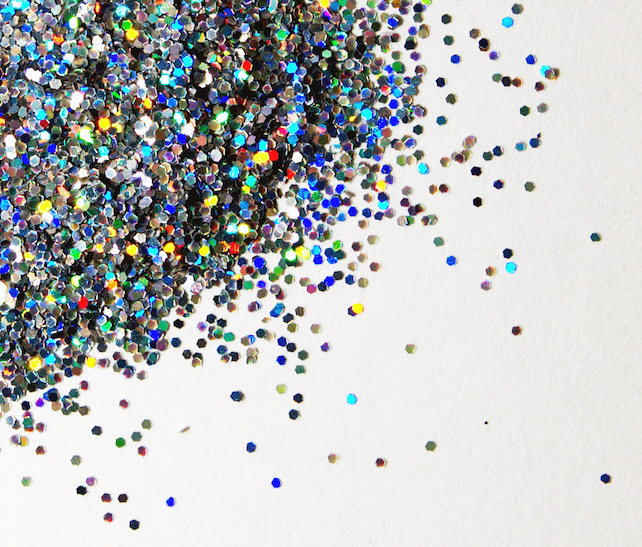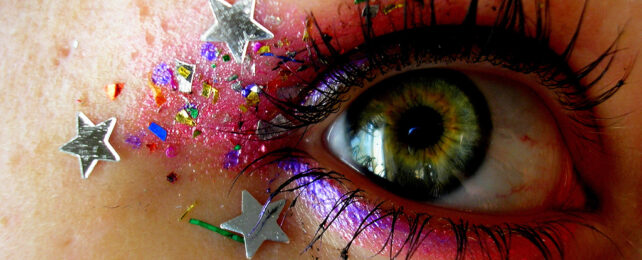All that glitters is not gold. Actual glitter, for instance, can be a surprisingly harmful environmental pollutant, as a new study demonstrates.
Despite its association with fun and frivolity, glitter has a dark side. Flecks of glitter reduce the amount of sunlight that penetrates into bodies of water, the new study shows, potentially impairing the ability of some aquatic plants to photosynthesize.
Glitter is essentially a microplastic in disguise, whose whimsical nature distracts from its insidious contributions to plastic pollution. That has begun changing to some degree, however, as seen in the recent ban on microplastic glitter in the European Union.
As a microplastic, glitter typically resists degradation, helping it persist and accumulate in the environment. And since it's often too small to be filtered by wastewater treatment plants, it can end up in waterways, potentially harming freshwater aquatic life or traveling on to pollute the ocean.
Led by researchers from the Federal University of São Carlos (UFSCar) in Brazil, the new study points to an additional problem.
While flecks of glitter are made of plastic – typically Mylar, the researchers note –they often feature a metallic coating, too, made from aluminum, bismuth, iron, or titanium. The presence of these metals can prevent aquatic plants from getting enough sunlight, the study suggests.
"These findings support the hypothesis we began with, which was that glitter interferes with photosynthesis, possibly owing to the reflection of light by the microplastic particles' metallic surface," says lead author Luana Lume Yoshida, a master's student at the Bioassay and Mathematical Modeling Laboratory (LBMM) in UFSCar's Department of Hydrobiology.
The study focused on the large-flowered waterweed (Egeria densa), a macrophyte or aquatic plant native to Argentina, Brazil, and Uruguay.
Macrophytes like this serve an array of ecosystem functions, the researchers note, such as providing food, shelter, shade, and oxygen for their neighbors.

They're also valuable in phytoremediation efforts, which rely on plants to help detoxify contaminated places, and for their oxygenation services, which are widely used in aquariums and artificial lakes.
Yoshida and her colleagues incubated 400 bits of the waterweed in flasks, using water they collected from the Monjolinho reservoir on the UFSCar campus. They also used common glitter, the type sold at retail stores, with an average particle surface area of 0.14 square millimeter.
The researchers grew waterweed among 0.04 grams of glitter per liter of water, and waterweed without glitter as a control, both in light and in darkness.
Photosynthesis rates were 1.54 times higher in the absence of glitter, the study found. Tiny glitter particles reduced the amount of light in the water, the researchers concluded, noting the plants' respiration was affected, too, but not as significantly.
If a macrophyte like this is affected, the effects may ripple much farther into the ecosystem, notes co-author Marcela Bianchessi da Cunha-Santino, one of LBMM's principal investigators.
"In this experiment, we specifically observed the physical interference of glitter in a species of macrophyte, but there are better-known references in the scientific literature to water contamination and consumption of these particles by other aquatic organisms," she says.
"We put all the pieces of the puzzle together and were able to describe the functioning of the entire ecosystem, as well as pointing out what can happen throughout the food chain," da Cunha-Santino adds. "That's the key difference of an ecological approach."
Given the limited research on concentrations and features of glitter that diffuses through our waterways, it's difficult estimating just how serious the problem might be. Levels in the investigation were extrapolated from experiments using various kinds of microplastics, leaving room for future fieldwork to provide clearer numbers.
More research is clearly needed to show glitter blocks significant levels of light from aquatic ecosystems in the wild, and determine how the inhabitants respond. Meanwhile, it's time to re-evaluate our relationship with glitter, says co-author Irineu Bianchini Jr., also a principal investigator at LBMM.
"For now it's important to warn society that changes in photosynthesis rates, however remote they may seem from our lives, are linked to other changes that affect us more directly, such as the decrease in primary production by food chains in aquatic environments," Bianchini Jr. says. "If there are more sustainable alternatives to glitter, why not switch to these right away?"
The study was published in the New Zealand Journal of Botany.
